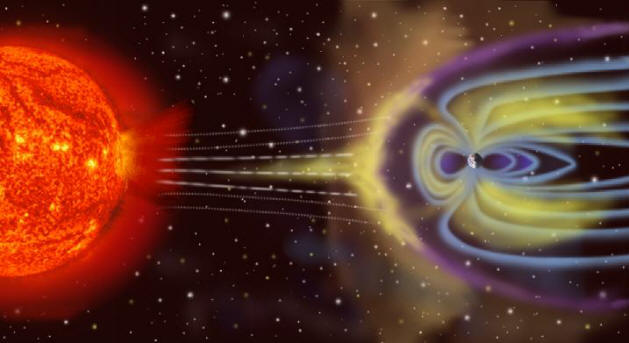Rigil Kentaurus ("Foot of the Centaur" in Arabic) is the fourth brightest star in the night sky as well as the brightest star in Constellation Centaurus. Like Sol, it is a yellow-orange main sequence dwarf star of spectral and luminosity type G2 V. It has about 1.105 ± 0.007 times Sol's mass (Guedes et al, 2008; and Thévenin et al, 2002) and 1.23 its diameter (ESO science release; and Demarque et al, 1986), and is about 52 to 60 percent brighter than Sol (ESO science release; and Demarque et al, 1986).
 NASA
NASA
Alpha Centauri A is a yellow-orange star
like our Sun, Sol. (See a 2MASS Survey
image of Alpha Centauri A and B from
the NASA Star and Exoplanet Database.)
Without consideration of interior seismic constraints, Star A (and B) has been estimated to be older than Sol, from 4.85 billion years in age (ESO) to around 7.6 (+/- around 10 percent) billion years or more -- or 6.8 billion years if it does not have a convective core (Guenther and Demarque, 2000). Recent recent interior modeling with seismic constraints, however, suggest that Stars A and B could be 5.6 to 5.9 billion years old (Mutlu Yildiz, 2007). Since Alpha Centauri A is very similar to our own Sun, however, many speculate whether it might contain planets that harbor life. Useful star catalogue numbers and designations for Alpha Centauri A include: Alp or Alf Cen A, Alp1 Cen, HR 5459, Gl 559 A, Hip 71683, HD 128620, CP(D)-60 5483, SAO 252838, FK5 538, and LHS 50.

© Torben Krogh & Mogens Winther,
(Amtsgymnasiet and EUC Syd Gallery,
student photo used with permission)
Alp Cen B is an orange-red dwarf star,
like Epsilon Eridani at left center of
meteor. (See a Sloan Digital Sky Survey
field images of Alpha Centauri A and B
from WikiSky.org, and at APOD.)
This much dimmer companion star is a main sequence, orange-red dwarf (K0-1 V). It appears to have only 93.4 ± 0.7 percent of Sol's mass (Guedes et al, 2008; and Thévenin et al, 2002), about 86.5 percent of its diameter, and 45 to 52 percent of its luminosity (ESO; and Johnson and Wright, 1983, page 681). Useful catalogue numbers and designations for Alpha Centauri B include: Alp or Alf Cen B, HR 5460, Gl 559 B, Hip 71681, HD 128621, and LHS 51.
Calculations by to Weigert and Holman (1997) indicated that the distance from the star where an Earth-type planet would be "comfortable" with liquid water is centered around 0.73 to 0.74 AU -- somewhat beyond the orbital distance of Venus in the Solar System -- with an orbital period under an Earth year using calculations based on Hart (1979). More recent calculations based on Kasting et al (1993), however, allow for a wider "habitable zone." Estimates provided by the NASA Star and Exoplanet Database, however, appear to be incorrect for this spectral class K star -- where the inner edge of Star B's habitable zone should be located around 1.20 AU from the star, while the outer edge edge lies around 2.38 AUs, and so estimates from 40 Omicron Eridani A (another K0-1 star) were applied as a rough proxy, which indicated that the inner edge of Star B's habitable zone could be located around 0.56 AU from the star, while the outer edge edge lies around 1.10 AUs.
 Arnold O. Benz, Institute of Astronomy, ETH Zurich
Arnold O. Benz, Institute of Astronomy, ETH Zurich
High resolution and jumbo images (Benz et al, 1998).
Proxima is a flare star, like UV Ceti (Luyten 726-8 B)
shown flaring at left. UV Ceti is an extreme example
of a flare star that can boost its brightness by five times
in less than a minute, then fall somewhat slower back
down to normal luminosity within two or three minutes
before flaring suddenly again after several hours.
Proxima Centauri b?
Using data collected up to early 1994, astronomers using the Hubble Space Telescope discerned a 77-day variation in the proper motion of Proxima (Benedict et al, 1994). The astrometric perturbations found could be due to the gravitational pull of a large planet with about 80 percent of Jupiter's mass at a 1994 separation from Proxima of about 0.17 AUs -- 17 percent of Earth's orbital distance in the Solar System from the distance, or less than half Mercury's orbital distance. The Hubble astrometry team calculated that the chance of a false positive reading from their data -- same perturbations without a planet -- to be around 25 percent.
 © Estate of John Whatmough -- larger image
© Estate of John Whatmough -- larger image
(Artwork from Extrasolar Visions, used with permission from Whatmough)
Glowing red through gravitational contraction, the candidate brown dwarf companion
to Proxima Centauri is depicted with two moons (one eclipsing the flare star) with
distant Alpha Centauri A and B at upper right, as imagined by Whatmough.
I
